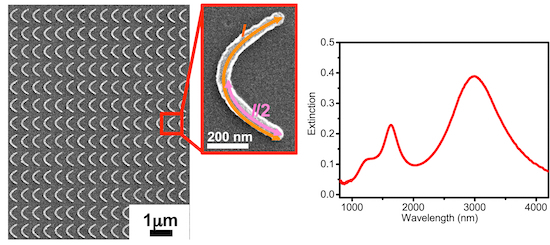Spectroscopic Properties of Gold Curvilinear Nanorod Arrays
Abstract
:1. Introduction
2. Experimental Section
2.1. Gold Nanorods Fabrication Process
2.2. Measurement of Extinction Spectra
3. Results and Discussion
3.1. Plasmon Peak Assignment of Gold Curvilinear Nanorods
3.2. Plasmon Resonant Peak by Controlling Arc Length of Gold Curvilinear Nanorods
3.3. Plasmon Resonant Peak by Controlling Arrangement of Gold Curvilinear Nanorods
4. Conclusions
Acknowledgments
Author Contributions
Conflicts of Interest
Abbreviations
| LSP | local-mode surface plasmon |
References
- Perez-Juste, J.; Pastoriza-Santos, I.; Liz-Marzan, L.M.; Mulvaney, P. Gold nanorods: Synthesis, Characterization and Applications. Coordin. Chem. Rev. 2005, 249, 1870–1901. [Google Scholar] [CrossRef]
- Jain, P.K.; Lee, K.S.; El-Sayed, I.H.; El-Sayed, M.A. Calculated Absorption and Scattering Properties of Gold Nanoparticles of Different Size, Shape, and Composition: Applications in Biological Imaging and Biomedicine. J. Phys. Chem. B 2006, 110, 7238–7248. [Google Scholar] [CrossRef] [PubMed]
- Zhang, S.; Genov, D.A.; Wang, Y.; Liu, M.; Zhang, X. Plasmon-Induced Transparency in Metamaterials. Phys. Rev. Lett. 2008, 101, 047401. [Google Scholar] [CrossRef] [PubMed]
- Smythe, E.J.; Cubukcu, E.; Capasso, F. Optical Properties of Surface Plasmon Resonances of Coupled Metallic Nanorods. Opt. Express 2007, 15, 7439–7447. [Google Scholar] [CrossRef] [PubMed]
- Ueno, K.; Mizeikis, V.; Juodkazis, S.; Sasaki, K.; Misawa, H. Optical Properties of Nanoengineered Gold Blocks. Opt. Lett. 2005, 30, 2158–2160. [Google Scholar] [CrossRef] [PubMed]
- Shalaev, V.M.; Cai, W.; Chettiar, U.K.; Yuan, H.-K.; Sarychev, A.K.; Drachev, V.P.; Kildishev, A.V. Negative Index of Refraction in Optical Metamaterials. Opt. Lett. 2005, 30, 3356–3358. [Google Scholar] [CrossRef] [PubMed]
- Ishikawa, A.; Tanaka, T.; Kawata, S. Negative Magnetic Permeability in the Visible Light Region. Phys. Rev. Lett. 2005, 95, 237401. [Google Scholar] [CrossRef] [PubMed]
- Murphy, C.J.; Gole, A.M.; Stone, J.W.; Sisco, P.N.; Alkilany, A.M.; Goldsmith, E.C.; Baxter, S.C. Gold Nanoparticles in Biology: Beyond Toxicity to Cellular Imaging. Accounts. Chem. Res. 2008, 41, 1721–1730. [Google Scholar] [CrossRef] [PubMed]
- Chung, T.; Lee, S.-Y.; Song, E.Y.; Chun, H.; Lee, B. Plasmonic Nanostructures for Nano-Scale Bio-Sensing. Sensors 2011, 11, 10907–10929. [Google Scholar] [CrossRef] [PubMed]
- Verellen, N.; Sonnefraud, Y.; Sobhani, H.; Hao, F.; Moshchalkov, V.V.; van Dorpe, P.V.; Nordlander, P.; Maier, S.A. Fano Resonances in Individual Coherent Plasmonic Nanocavities. Nano Lett. 2009, 9, 1663–1667. [Google Scholar] [CrossRef] [PubMed]
- Woo, K.C.; Shao, L.; Chen, H.; Liang, Y.; Wang, J.; Lin, H.-Q. Universal Scaling and Fano Resonance in the Plasmon Coupling between Gold Nanorods. ACS Nano 2011, 5, 5976–5986. [Google Scholar] [CrossRef] [PubMed]
- Shao, L.; Fang, C.; Chen, H.; Man, Y.C.; Wang, J.; Lin, H.-Q. Distinct Plasmonic Manifestation on Gold Nanorods Induced by the Spatial Perturbation of Small Gold Nanospheres. Nano Lett. 2012, 12, 1424–1430. [Google Scholar] [CrossRef] [PubMed]
- Mirin, N.A.; Bao, K.; Nordlander, P. Fano Resonances in Plasmonic Nanoparticle Aggregates. J. Phys. Chem. A 2009, 113, 4028–4034. [Google Scholar] [CrossRef] [PubMed]
- Hentschel, M.; Saliba, M.; Vogelgesang, R.; Giessen, H.; Alivisatos, A.P.; Liu, N. Transition from Isolated to Collective Modes in Plasmonic Oligomers. Nano Lett. 2010, 10, 2721–2726. [Google Scholar] [CrossRef] [PubMed]
- Stokes, N.; Cortie, M.B.; Davis, T.J.; McDonagh, A.M. Plasmon Resonances in V-Shaped Gold Nanostructures. Plasmonics 2012, 7, 235–243. [Google Scholar] [CrossRef]
- Husu, H.; Makitalo, J.; Laukkanen, J.; Kuittinen, M.; Kauranen, M. Particle Plasmon Resonances in L-shaped Gold Nanoparticles. Opt. Express 2007, 18, 16601–16606. [Google Scholar] [CrossRef] [PubMed]
- Halas, N.J.; Lal, S.; Chang, W.-S.; Link, S.; Nordlander, P. Plasmons in Strongly Coupled Metallic Nanostructures. Chem. Rev. 2011, 111, 3913–3961. [Google Scholar] [CrossRef] [PubMed]
- Ueno, K.; Juodkazis, S.; Mizeikis, V.; Sasaki, K.; Misawa, H. Clusters of Closely Spaced Gold Nanoparticles as a Source of Two-Photon Photoluminescence at Visible Wavelengths. Adv. Mater. 2008, 20, 26–30. [Google Scholar] [CrossRef]
- Tomioka, T.; Kubo, S.; Nakagawa, M.; Hoga, M.; Tanaka, T. Split-ring Resonators Interacting with a Magnetic Field at Visible Frequencies. Appl. Phys. Lett. 2013, 103, 071104. [Google Scholar] [CrossRef]









© 2016 by the authors; licensee MDPI, Basel, Switzerland. This article is an open access article distributed under the terms and conditions of the Creative Commons by Attribution (CC-BY) license (http://creativecommons.org/licenses/by/4.0/).
Share and Cite
Yokota, Y.; Ueno, K.; Misawa, H.; Tanaka, T. Spectroscopic Properties of Gold Curvilinear Nanorod Arrays. Photonics 2016, 3, 18. https://doi.org/10.3390/photonics3020018
Yokota Y, Ueno K, Misawa H, Tanaka T. Spectroscopic Properties of Gold Curvilinear Nanorod Arrays. Photonics. 2016; 3(2):18. https://doi.org/10.3390/photonics3020018
Chicago/Turabian StyleYokota, Yukie, Kosei Ueno, Hiroaki Misawa, and Takuo Tanaka. 2016. "Spectroscopic Properties of Gold Curvilinear Nanorod Arrays" Photonics 3, no. 2: 18. https://doi.org/10.3390/photonics3020018




